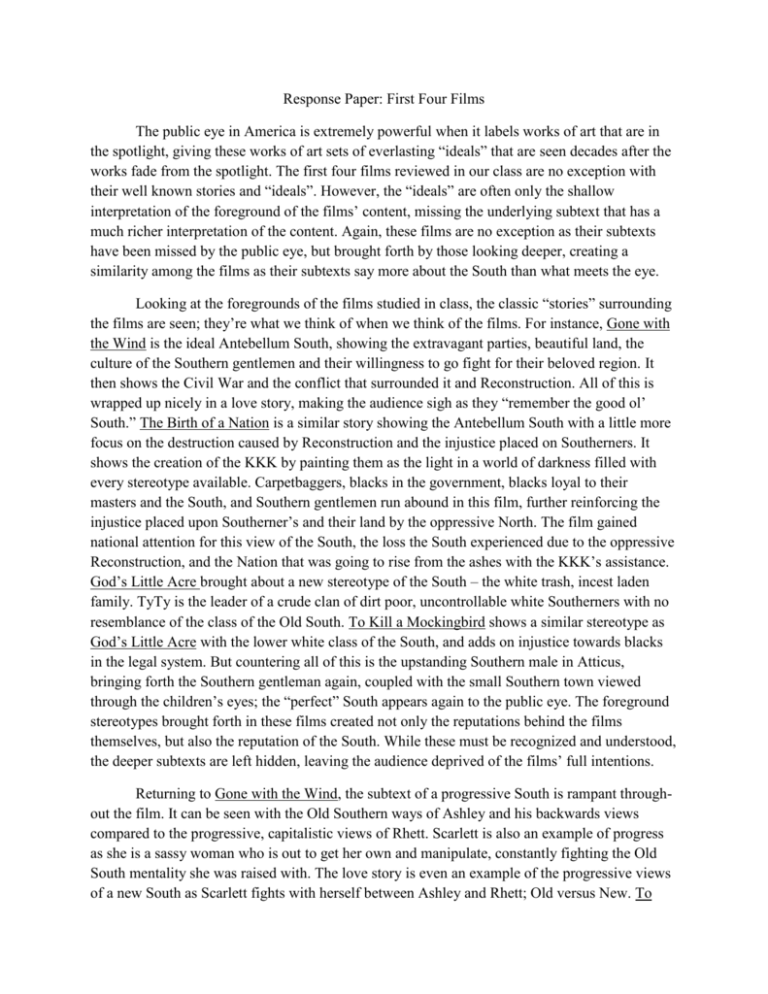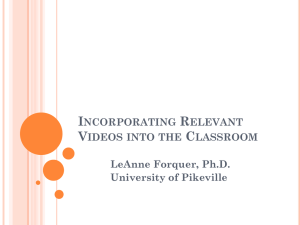respons4_2 - WordPress.com
advertisement

Response Paper: First Four Films The public eye in America is extremely powerful when it labels works of art that are in the spotlight, giving these works of art sets of everlasting “ideals” that are seen decades after the works fade from the spotlight. The first four films reviewed in our class are no exception with their well known stories and “ideals”. However, the “ideals” are often only the shallow interpretation of the foreground of the films’ content, missing the underlying subtext that has a much richer interpretation of the content. Again, these films are no exception as their subtexts have been missed by the public eye, but brought forth by those looking deeper, creating a similarity among the films as their subtexts say more about the South than what meets the eye. Looking at the foregrounds of the films studied in class, the classic “stories” surrounding the films are seen; they’re what we think of when we think of the films. For instance, Gone with the Wind is the ideal Antebellum South, showing the extravagant parties, beautiful land, the culture of the Southern gentlemen and their willingness to go fight for their beloved region. It then shows the Civil War and the conflict that surrounded it and Reconstruction. All of this is wrapped up nicely in a love story, making the audience sigh as they “remember the good ol’ South.” The Birth of a Nation is a similar story showing the Antebellum South with a little more focus on the destruction caused by Reconstruction and the injustice placed on Southerners. It shows the creation of the KKK by painting them as the light in a world of darkness filled with every stereotype available. Carpetbaggers, blacks in the government, blacks loyal to their masters and the South, and Southern gentlemen run abound in this film, further reinforcing the injustice placed upon Southerner’s and their land by the oppressive North. The film gained national attention for this view of the South, the loss the South experienced due to the oppressive Reconstruction, and the Nation that was going to rise from the ashes with the KKK’s assistance. God’s Little Acre brought about a new stereotype of the South – the white trash, incest laden family. TyTy is the leader of a crude clan of dirt poor, uncontrollable white Southerners with no resemblance of the class of the Old South. To Kill a Mockingbird shows a similar stereotype as God’s Little Acre with the lower white class of the South, and adds on injustice towards blacks in the legal system. But countering all of this is the upstanding Southern male in Atticus, bringing forth the Southern gentleman again, coupled with the small Southern town viewed through the children’s eyes; the “perfect” South appears again to the public eye. The foreground stereotypes brought forth in these films created not only the reputations behind the films themselves, but also the reputation of the South. While these must be recognized and understood, the deeper subtexts are left hidden, leaving the audience deprived of the films’ full intentions. Returning to Gone with the Wind, the subtext of a progressive South is rampant throughout the film. It can be seen with the Old Southern ways of Ashley and his backwards views compared to the progressive, capitalistic views of Rhett. Scarlett is also an example of progress as she is a sassy woman who is out to get her own and manipulate, constantly fighting the Old South mentality she was raised with. The love story is even an example of the progressive views of a new South as Scarlett fights with herself between Ashley and Rhett; Old versus New. To Kill a Mockingbird shows another progressive view of the South and class, and that is through the different classes of whites seen in the film. Atticus is the noble, high class white without racist views. He stands against the working/ farming class of gentlemen, but who have racist tendencies, and of course the low class, white trash, blatantly racist Ewells. The injustice towards the blacks in the film seen in the trial is simply another reinforcement of the class struggles among whites in the South, showing the pure hierarchy and the loss of cleanliness as you go down in class. Showing this similar idea of class in its foreground, God’s Little Acre has a subtext that focuses on human nature rather than class. The idea of a poor, lower class, separated from structured society allowed Caldwell to bring about the animalistic ways of human nature. The pursuance of females by the man’s man Will, and their acceptance of his force, along with the dynamic between the men, shows the animal inside man and his disregard for family or societal norms when without structure in desperate times. When looking at these three films, the stereotypes used by them bring a strong pathos to the table, evoking the films’ feelings upon the audience. Although the subtext is lost, to the shadow of the foreground, it is surprisingly present in the audience’s subconscious. They are all propaganda, projecting the author’s/ director’s subtext onto the audience. The Birth of a Nation is the largest of the propaganda piece among the films. The Birth of a Nation paints the KKK in a fantastic light as they are fighting to save the ideal way of Old Southern living. They can do no wrong against the force of Northern oppression and a South in despair. Although the film may not say directly to join or support the KKK, the message is pretty clear, imprinting the KKK into the audience’s minds as they view the film and leave the theater. The subtexts present in the works are the most important content, and as they are sit in the shadows of the foreground, they bring the movies together as their deeper meanings lay hidden. So as we look for similarities and differences among the films that have captured the spotlights of the past, perhaps it would do us well to look for the deeper meaning behind the foregrounds of romance, lost culture, and heroism. In the cases of these four films, the subtexts have much more to say about the underlying feelings and subconscious of the South compared to the Southern stereotypes that their foregrounds produced. When looking to understand the South, the foregrounds offer the quick fix to Southern culture past and present, but we miss the raw emotions and conflict found deep within the Southern ways shape what the Southern core.






